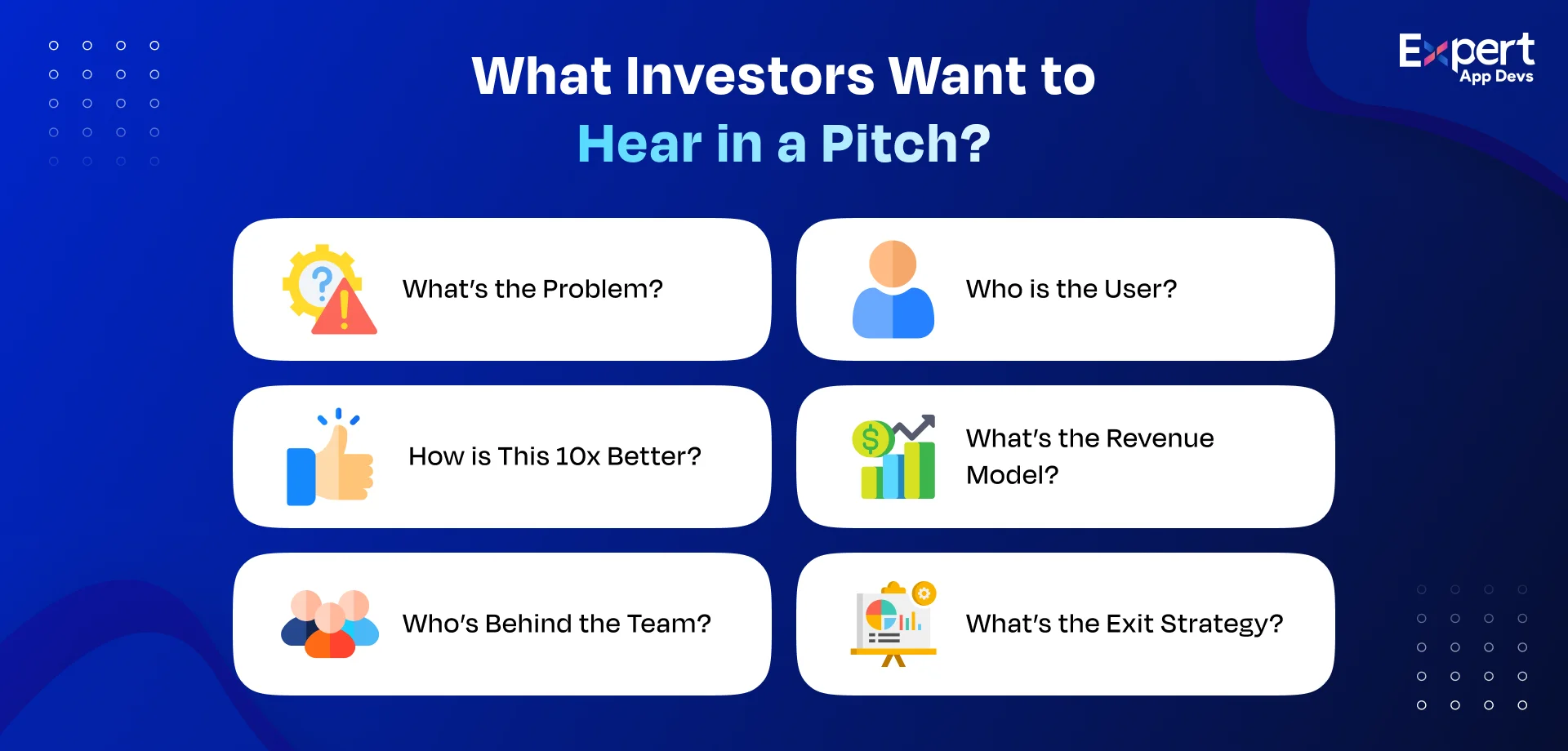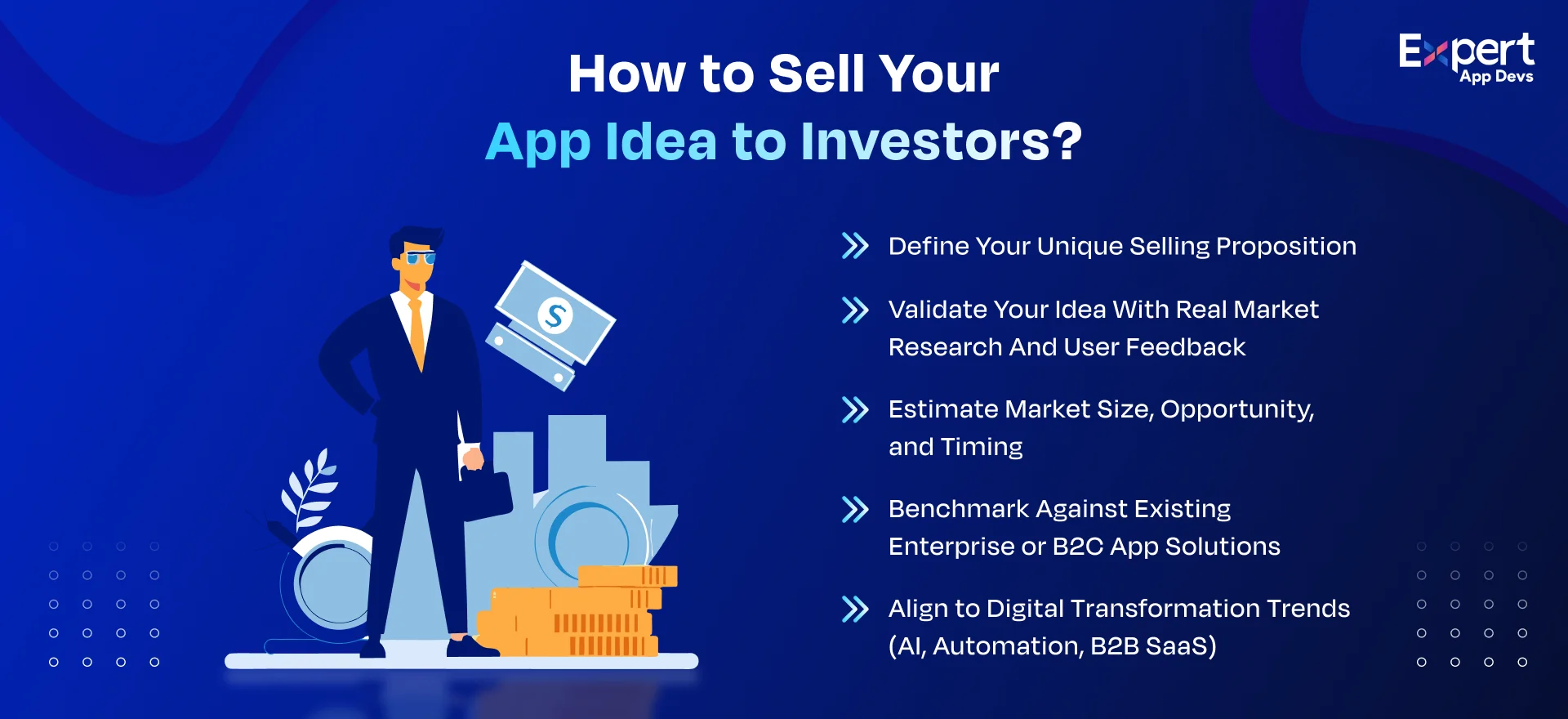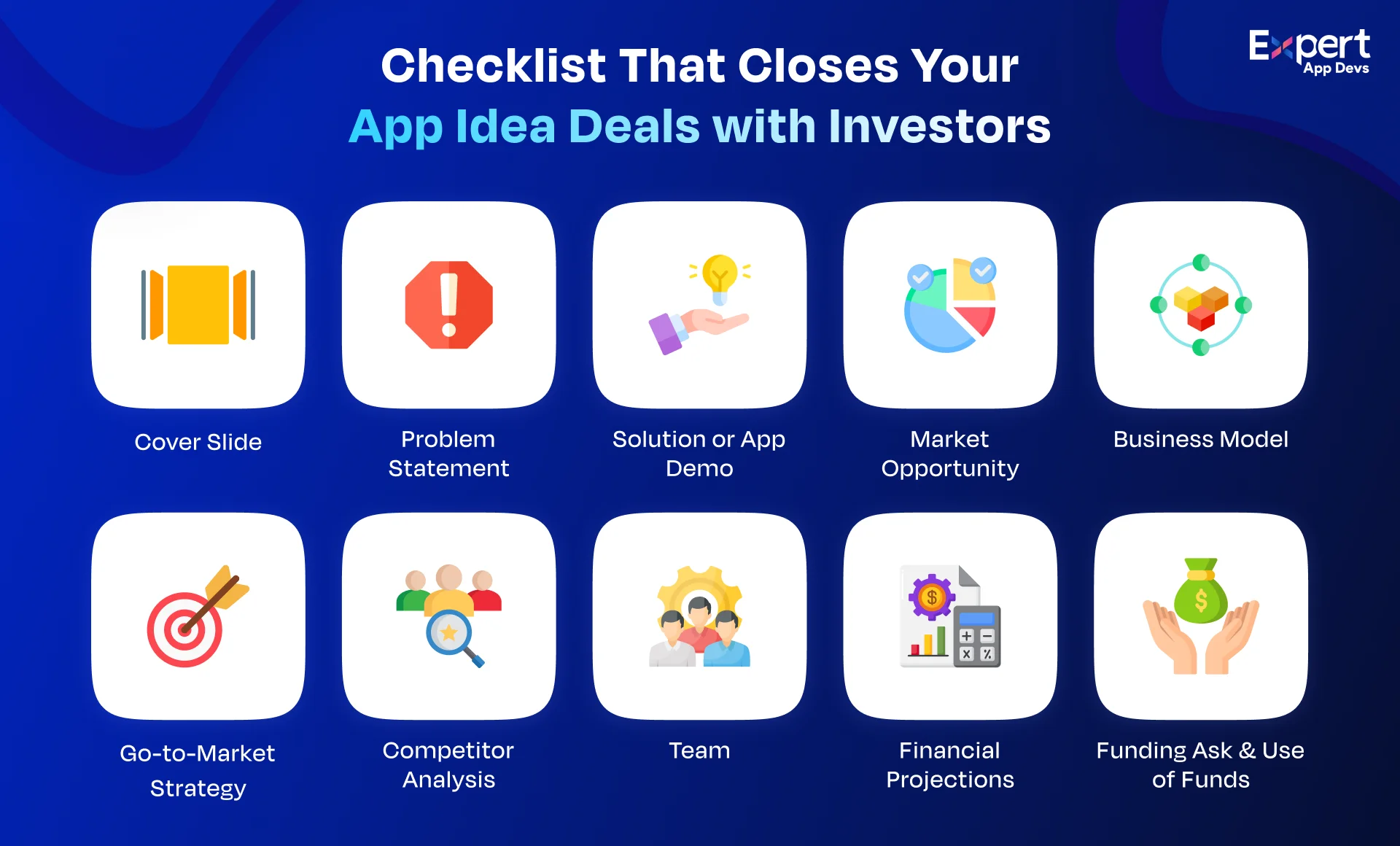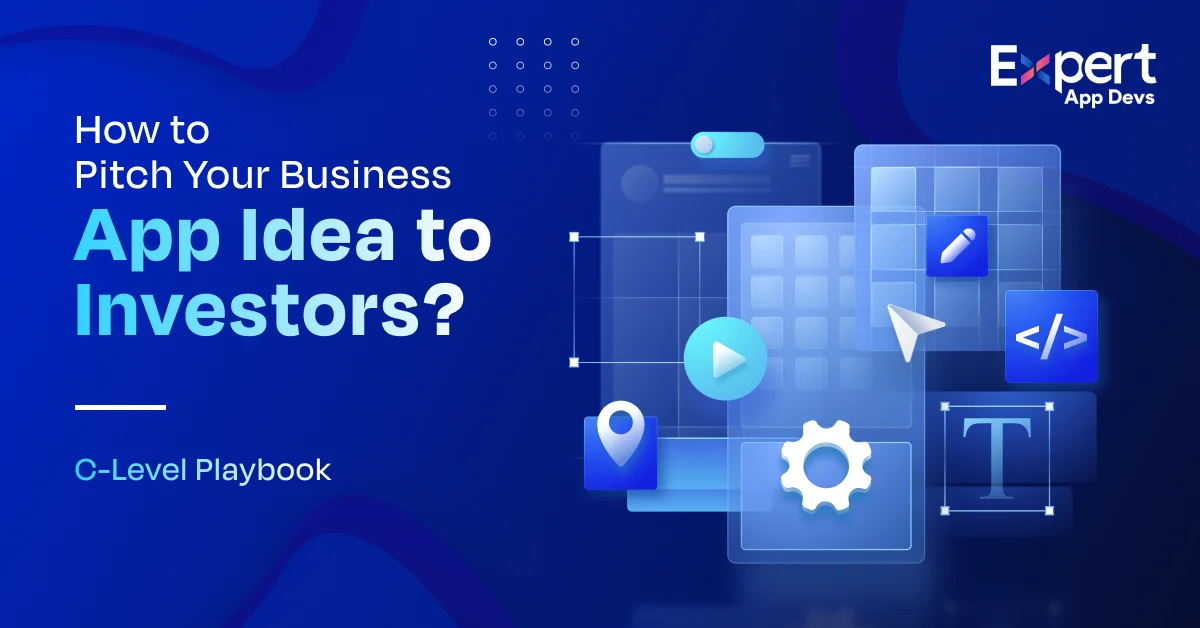How to Pitch Your Business App Idea to Investors: A C-Level Playbook
Do you know that only 1 out of 200 startups gets funded? Your pitch can either make or break your funding journey. This article is for angel investors, C-level leaders, business owners, VCs and entrepreneurs seeking to pitch to investors. Whether you’re at the idea stage or MVP, this article discusses how to structure your pitch deck, communicate your vision, and win investor trust.
Funding is the essential factor to have a great start to a business. Having just an amazing app idea is not enough, it needs a good pitch to convince investors why your business is worth investing in. Investors aren’t just buying into your product, they’re investing in your clarity, team, and potential to scale. According to recent statistics, there are over 2.06 million apps available on the Google Play Store and 1.64 million apps on the App Store. So, the very first thing, your app idea must be unique and stand out, and solve real business and users’ problems as well as be profitable.
The harsh truth is that only 0.5% of startups are getting funding. But don't worry, if you don't know how to pitch idea to company, here is the guide to pitching your business app idea with confidence. This article breaks down exactly what investors want to see when evaluating a business app.
First, let's start by what are the reasons behind the failed pitch.
Why Your App Pitch Fail Before It Starts?
Every startup has its own way of presenting the business app idea, but what matters is pitch should give clarity, satisfaction, and clear all doubts of investors related to problems you are gonna solve, market-fit, monetization logic, and more. There are multiple reasons why your app pitch fails.
Most pitches fail because of a lack of clarity, problem-market fit, or monetization logic. These three are high-priority factors.
Below are the common mistakes C-level leaders and founders make:
- Weak Problem Definition
- Focusing Too Much on Features, Not ROI
- No Clear Target Market
- Overly Technical or Jargon-Filled Pitch
- No proof of concept
- Poor Visual Presentation
- Unrealistic Business Model
- No Competitive Differentiation
- Weak or inexperienced founding team
- Skipping User Validation
Warren Buffett said it best: “Never invest in a business you cannot understand.” If investors don’t quickly get what your app does, who it’s for, or how it makes money, they’ll walk away. Keeping your pitch clear and easy to follow is key to getting their attention—and their support.
Investor Psychology: What C-Level Execs and VCs Want to Hear
It's important to understand the investor's psychology first to get the funding easily with less effort and explanation. Investors think in terms of growth, risk, and returns. Hence, when presenting the pitch, it's important to talk in investors' language and use terms like metrics, Moats, ROI, TAM, etc.
Be prepared with the following questions before going to pitch the app idea to investors.

#1. What’s the Problem?
The world is filled with lots of problems. An app that solves real-world problems has high chances of success, hence, the app idea must solve real-world pain points. Make sure you clearly explain why this problem matters and why now is the right time to solve it. If the problem isn’t strong enough, the pitch might not work.
#2. Who is the User?
Mention who the target users of the app such as busy professionals, parents, startups, hospitals, or any specific industry. Show that you’ve studied their needs, behaviors, and pain points. The more specific and focused you are, the easier it is to market, sell, and grow your user base.
#3. How is This 10x Better?
Obviously, your app solution has to be 10x better to convince the investors to fund it. The idea should not be similar to other apps in the market, and solve a problem that is not been solved yet. highlight your unique features, technology benefits, user experience, and other plus points.
#4. What’s the Revenue Model?
Investors care about how you’ll make money. Explain to them if your revenue model includes subscription, takes a cut of transactions, or offers freemium plans. The revenue model should be scalable and aligned with how users are willing to pay.
#5. Who’s Behind the Team?
Investors look for founders with relevant experience, technical skills, and the grit to execute under pressure. Highlight your team’s background, industry knowledge, and why you’re the right people to solve this problem. Eventually confident team creates a confident product.
#6. What’s the Exit Strategy?
An exit strategy is a plan that describes how a business will make a profit. It is either by selling the company, transferring ownership, or getting acquired by a big player, reducing stakes, and more.
This basically gives an idea of how and when to exit from business by limiting loss.
How to Build a Winning Business Case for Your App Idea?
Every entrepreneur comes with a strong idea, hence there is already competition in getting funding. Here are the important points on how you can make a great investment pitch.

#1. Define Your Unique Selling Proposition
USP is the crucial factor that makes your app sell faster. It can be any beneficial features like affordability, advanced technologies, and more. Make sure your unique selling points are unique from others in the market and solve unique pain points. This will increase the chances of attracting investors.
#2. Validate Your Idea With Real Market Research And User Feedback
Before you spend time and money building your app, make sure people actually want it. Talk to potential users, run surveys, and study how they’re solving the problem today. Find out what they like, what frustrates them, and what’s missing. This kind of real-world validation shows investors that there’s real demand.
#3. Estimate Market Size, Opportunity, and Timing
Research the market size of the app you are making. How big is your market, and what opportunities does it bring? Use TAM, SAM, and SOM to estimate your potential market: Total, Serviceable, and Obtainable Market. This shows how many people or businesses could realistically use your app. Also, think about timing: why is now the right time to launch this solution to the market?
#4. Benchmark Against Existing Enterprise or B2C App Solutions
Look at competitors and similar products to see what’s already out there. How does your app compare in terms of features, pricing, and user experience? This helps you identify gaps in the market and fine-tune your approach. It also proves to investors that you’ve done your homework.
#5. Align to Digital Transformation Trends (AI, Automation, B2B SaaS)
Today’s world is digital. Modern investors will look for modern solutions, hence, your app idea must align with the digital transformation. Include AI, automation, or SaaS models, and other modern technologies in your app idea to explain how things like automation will make things easier and personalize things for a better experience.
How to Create a Pitch Deck That Sells Your App Idea?
A great business app pitch deck tells your story clearly and shows the value behind your idea. When you are making a presentation or pitch deck, every part is important, hence, it’s not just slides, it’s your chance to prove you’ve got a solid plan. If you want to close your investment deals, here are the 10 slides that will turn interest into investment.

#1. Cover Slide
This is important, and the first slide will make the first impression of your app idea. It should contain an intro about you, your app, and why you are here. Add an app logo that relates to the app idea or industry, with a catchy tag line that is easy to remember. The goal here is to spark interest and give your audience a quick feel for your brand.
#2. Problem Statement
What pain point are you solving? Every app solves some or other problem for users and the industry. Highlight what problem your app solves, such as price factors, user convenience, experience, speed, etc. Explain who experiences the problem and why existing solutions aren’t working well enough. Your problem statement should be easy to understand, even for those outside the industry.
#3. Solution or App Demo
This part would include wireframes, screenshots of apps with working app. Show how your app solves the issues. Make sure the solution is easy to use by investors when they try your demo. You can present multiple solutions to the problem statement, which will show that you have done great research about this use case.
#4. Market Opportunity
This slide needs to show how big an opportunity your app brings. Include TAM (Total Addressable Market), SAM (Serviceable Available Market), and SOM (Serviceable Obtainable Market) to break it down. Explain how many people or businesses need your solution and how much they might spend. Add industry reports and market studies from reputed sources to add credibility.
#5. Business Model
This slide is about how your app will generate revenue. Discuss transparently your pricing structure, subscriptions, pay-per-use, freemium upgrades, ads, or enterprise licensing. if your MVP has already converted users, it will be a great plus point.
#6. Go-to-Market Strategy (B2B, B2C, enterprise strategy)
In this slide, you are supposed to add the market strategy from start to end. How will you launch your app in the market, attract users, and grow? Will you target businesses (B2B), consumers (B2C), or both? What channels will you use SEO, social media, partnerships, outbound sales? Explain the first 6-12 month plan with the investors.
#7. Competitor Analysis
This slide should contain competitors' studies. Use a comparison chart or grid to highlight how your app compares to others and how it's unique. Focus on key differentiators—price, features, user experience, or niche focus. Mention well-known competitors and their history in the PPT and explain how you stand apart or outperform.
#8. Team
The people behind the innovation are important. Include the brief bios and backgrounds of each team member. This will give investors an idea about the experienced team's skills and background. Make it clear why this team is the right one to solve this problem. If you have advisors, notable hires, or tech partners, include them too. A strong, well-rounded team builds confidence in your ability to execute.
#9. Financial Projections
Investors will spend more time on financial projections, as it is about growth, and where do you see yourself in the next 5 years? Make this slide interesting and easy to understand by adding colorful bar charts. As you are asking for funds, include labour, office space, burn rate (monthly spend), marketing, hardware, IT, and all other things. Keep it simple and real, This slide should make investors understand how the fund is going to be used and how much profit is likely to be generated in the next 5 years.
10. Funding Ask & Use of Funds
Your funding ask should be practical and logical, which gives clarity on what and how. Tell investors how much funding you’re seeking and how you’ll use it. Break it down by team expansion, marketing, product development, etc. Also, share what milestones you expect to hit with this funding, like user growth, revenue targets, or new feature launches.
Demo of App Pitches
To give you more clarity on how you should pitch, here are the demos of various industries. This will help you start right and pitch correctly without missing anything.
#1. Fintech App Development
Here is the sample pitch for pitching fintech app investors:
“Everyone wants to save money, but it's hardly possible these days, where young generations spend easily. That’s why we built SaveSmart, a fintech app that rounds up everyday purchases and invests spare change automatically. With 70% of users completing onboarding in under 2 minutes, we’ve quickly grown to 50,000 active users and a $9 ARPU in just six months. Today, we’re asking for $5 million to expand features and scale nationwide. Join us to transform how Gen Z builds wealth.”
The above pitch has a purpose to help young adults. The problem statement here is saving money in the fast digital world. USP highlights easy sign-up, and it has real numbers like $9 ARPU and 50,000 users. Hence, this makes a great pitch.
#2. HealthTech App Development
Here is the pitch sample for a health tech app:
“We waste countless hours on paperwork and insurance headaches, which slow patient care. CareSync solves this by making work easier for full insurance compliance. It cuts admin time by 30%. After a successful pilot with two major hospitals, we’re seeking $4 million to expand our team and launch nationwide. Join us in transforming healthcare and improving patient outcomes across the country.”
#3. B2B SaaS App Development
Here is how you should pitch if your app idea is related to a B2B SaaS app:
“Managing vendors is a real headache for big companies—lots of time wasted and costs piling up. That’s why we built VendorFlow, a simple platform that makes vendor tracking and procurement easy, boosting efficiency by 40%. We’re already making $200K a month with a low cost to get each customer. Now, we’re asking for $3 million to improve the product and grow our sales team. Join us in changing how businesses manage vendors.”
Expert Tips for High-Stakes Pitches
Follow the below expert tips to land high-stakes pitches.
#1. Personalize your pitch for angel investors, VCs, or corporate boards
Angel investors use their own funds, and venture capitalists use their investment fund. Every investor thinks differently about business, no matter how good your business is. It's important that your pitch aligns with their thinking, like angel investors usually care about passion and vision, while venture capitalists focus on market size and big returns.
#2. Storytelling vs. Data: Strike a balance
Stories are a great way to present your business idea. It helps to connect emotionally and logically. Start your pitch with a story about how this idea came, what problem did you noticed. and how your app is the best idea to solve the specific challenges users are facing. Talk about statistics and real-life examples about people who faced challenges and why your app idea is a game-changer.
#3. How to handle hard questions
You are making the app and asking for funds from investors, so tough questions will come. You must be able to answer the logical questions. Be prepared with user numbers, churn rates, your competitors, your uniqueness, profit in that industry, risks involved, solutions, and other things. Asking for funding should justify your app idea.
#4. Virtual pitch best practices
If you are pitching virtually over a laptop, make sure to have a proper setup and a calm environment. Make sure your slides sync with what you’re saying, don’t read off them. Use a clean background, make eye contact with the camera, and test your audio.
Investor-Ready Checklist: What to Finalize Before Pitch Day?
The day before the pitch is more important, hence it needs extra attention to make sure everything is available and going as planned. Most problems occur last moment. Here is the checklist you need to confirm before pitch day.
#1. MVP or Clickable Prototype
Investors want to see something, not just hear ideas. Whether it’s a working version (MVP) or just a clickable design, you should have something that shows how the app works. It doesn’t have to be perfect, but it should be clear enough for them to understand the user journey and value you’re offering.
#2. Market Research and Customer Discovery
You need to prove that real people want your app. Show you’ve talked to users, understand their pain points, and validated the problem. Include stats, surveys, or early feedback, this shows you're solving a real need, not building in a bubble.
#3. Legal/IP Protection
Before pitch day, make sure your legal basics are covered. Protect your app name with a trademark, and have NDAs ready if needed. It helps investors take you more seriously and protects your idea during early discussions.
#4. Clean Cap Table
Your cap table (ownership breakdown) should be simple, transparent, and up to date. Avoid messy equity splits, unclear agreements, or untracked investments. A clean cap table builds trust and makes it easier for new investors to join without legal hiccups.
#5. Data Room Access
Prepare a digital folder (like a Google Drive or Dropbox) with important documents: past spending, future projections, user growth, contracts, etc. This is your data room for Financials, Projections, and Due Diligence. It shows you're organized and ready for due diligence when investors ask for deeper info after your pitch.
#6. Pitch Deck + Appendix + FAQs
Your main deck should be sharp, clear, and visual. But don’t stop there—have an appendix with extra info (detailed metrics, product roadmap, case studies), and prep for FAQs like: “What’s your churn rate?” or “How do you scale?” This makes you look confident and prepared.
Post-Pitch Strategies to Keep Investors Engaged
After the pitch, investors usually take time to review. They may ask follow-up questions and do due diligence. Here is what you should do after pitching.
#1. Follow-up Strategy
Good behaviour and gentle follow-up are a must, this shows your interests and dedication. Stay in touch with investors and send thank-you notes, and answer their questions promptly. Provide any extra info they request. This will help you to stay in their mind, and they will think about your app idea.
#2. Managing Investor Expectations
Be honest and realistic about what investors can expect next, to make sure you meet their expectations. Discuss timelines, milestones, and risks.
#3. Milestone Reporting & Burn Monitoring
Keep investors updated on your progress and how you’re using their money (burn rate). Share milestone achievements and financial tracking to update them that you’re on track and managing resources wisely.
#4. Preparing for Series A/B scale
Series A/B are the next rounds after the pitch. If you’re successful, the next step is planning bigger rounds like Series A or B. Use feedback from current investors to improve your strategy, strengthen your product, and show clear growth plans to attract future funding.
Conclusion: C-Level Moves for Funding Success
Hope you found the above article useful to get an idea of how to pitch an idea to a company in the right manner. Above we have discussed the reason why most app pitch fails, how investors think, factors they consider and expert tips to land a good funding. You don't need to be a pitching pro, you just need to understand the above things, industry, your investor's choice and tailor your pitch accordingly. Other than this, use the latest technologies and different USPs to solve real users' problems and present your idea with confidence and you will definitely raise good funds for your app idea.
If you’re serious about getting funded, Expert App Devs can support your business journey. Book a demo consultation call with our experts to learn how we can help you with your business idea.
READ MORE: How to Get Investors For Your App Idea to Reality?
 Vaibhav Patel
Vaibhav Patel




